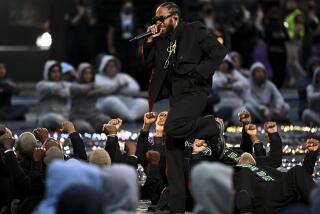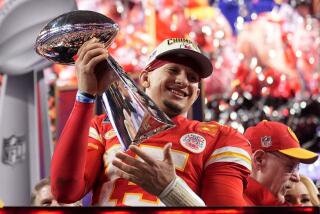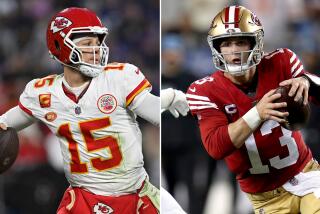SUPER BOWL XXII : WASHINGTON REDSKINS vs. DENVER BRONCOS : Notebook : Mark Haynes’ Return Is a Story That Might Be Difficult to Cover
- Share via
SAN DIEGO — When the Denver Broncos land here today to begin work for Sunday’s Super Bowl game, they’ll get off the plane with a new cornerback, Mark Haynes, replacing Louis Wright, the all-pro veteran who retired after last year’s Super Bowl experience in Pasadena.
Actually, Haynes was with Denver last year, too, but he was considered the club’s major disappointment at that time. He has made a miraculous recovery. Nobody except John Elway was more help to the Broncos this winter in the playoff wins that have advanced them to San Diego.
“I’m glad he’s finally repaying us for our investment in him,” Coach Dan Reeves said the other day.
The size of that investment--the Broncos gave up two second-round draft choices and a sixth--surprised a number of people in New York, where the Giants didn’t think he was worth two 12ths and a 13th.
Shortly afterward, when Haynes proved that he couldn’t cover anybody or catch anybody, Reeves agreed wholeheartedly with the Giants. And, basically, Haynes sat out 1986, when Reeves concluded that the Giants definitely knew something about the man that he didn’t.
This winter, that’s all changed. Good thing, too. The Washington Redskins, who have won the right to battle the Broncos for the National Football League championship, are a team with numerous fast, little, excellent pass receivers. Somebody will have to cover them, and Wright can’t, he’s gone. Paging Mark Haynes.
It would be fun to ask him what he thinks about all this, but Haynes hasn’t talked much lately, not to reporters anyway. He hasn’t really talked at all.
What we’re leading up to is this. Will Mark Haynes be the Duane Thomas of Super Bowl XXII? In the years when the Dallas Cowboys were in this game, long, long ago, Thomas was their most celebrated non-talker. Will Haynes continue his silent treatment of the press, or will he fool us and open up in San Diego?
Here are some of the things we would like to know:
--What happened to him in New York? After the Giants drafted him No. 1 out of Colorado in 1980, Haynes made all-pro instantly and went on to stardom in several Pro Bowl games, then his game fell off, then he dropped out of sight. By 1986, the Giants couldn’t wait to trade him. Why?
--What has he done to get it back in Denver? He was a living legend for a spell in New York. How does he feel about replacing a Denver legend, how did he do it, and why didn’t he get the job done last year?
It is a fact of life in pro football that no team ever gets rid of a good cornerback, yet the Giants willingly got rid of Haynes last year, when he was only 27, and congratulated themselves on stealing two seconds and a sixth.
And here he comes with a Super Bowl team.
Here he comes to cover Gary Clark or Ricky Sanders or whoever the Redskins throw at him, maybe even Art Monk, and it would be great to hear about all that from Haynes himself.
Will he talk?
The editors of Pro Football Weekly, reviewing the better anecdotes of all the Super Bowl years, came up with this one in this week’s edition.
It’s about Bob Asher, a rookie who was a backup tackle with Dallas in one Super Bowl game, who was talking with a friend.
“I’ve never seen so many newspapermen in my life,” Asher said. “Tell the truth, I’m getting tired of answering the same question over and over.”
What question, he was asked.
“What’s your name?” said Asher straight-faced.
Al LoCasale, the Raider executive assistant, said it’s an odds-on bet that the big play here Sunday will be made by one of two players.
Both are quarterbacks, John Elway of Denver and Doug Williams of Washington.
“A quarterback is the only one who can make a big play single-handedly,” LoCasale said.
“Backs need blockers. A wide receiver needs a passer. No lineman ever recovered a big fumble unless somebody fumbled.
“Quarterbacks don’t need anybody.”
LoCasale picks Elway to be the star of the game for reasons that bear listening to.
“Elway can make three kinds of big plays,” the Raider executive said. “He can beat you running or passing, but most significant of all, he can do it on rollouts because he still has the whole field to throw into.
“Most passers, when they roll out, lose half the field. Elway doesn’t lose anything. His arm is so strong that he can sprint wide right and throw back to his left with as much power as if he had rolled left.”
The San Diego Police Dept., which has 1,660 officers, has assigned 600 of them to patrol the various Super Bowl neighborhoods this week, mostly on overtime, and a spokesman said the department will have half the force working the stadium and other football hangouts Sunday.
It is handling Super Bowl security at an estimated cost of $200,000. That’s on top of the $1.1 million that the city has already invested in stadium improvements. And best of all, San Diego’s visitors this week are being asked to pay for it all.
The municipal nest egg is coming from the city’s 7% hotel room tax.
Not that San Diego is different. All Super Bowl cities, seeking national publicity, finance the venture by socking visitors, who, if they can afford $150 to $1,500 for a ticket to the game, can surely afford just a little more. That’s the thought, anyhow.
The security investment here includes the cost of fighting prostitution this week with 27 police officers.
Joe Gibbs brought the Redskins into San Diego at 9 p.m. Sunday--a day early--and said that the players had talked him into it.
NFL rules require Super Bowl teams to be on the grounds the Monday before the game. Said Gibbs: “The guys wanted to get out here, relax and enjoy themselves for a day before our hard practice week starts Wednesday.”
Art Monk “looks good in practice” Gibbs said of his injured wide receiver, who will probably start.
More to Read
Go beyond the scoreboard
Get the latest on L.A.'s teams in the daily Sports Report newsletter.
You may occasionally receive promotional content from the Los Angeles Times.










